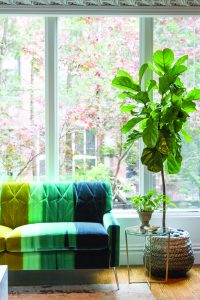Nature Nurtures: Biophilic Design
26 Oct 2022
Biophilic design honors our innate need to connect with the natural world
By Robyn Griggs Lawrence
Morning sunlight streams through an east-facing window as a breeze gently lifts gauzy curtains. Hummingbirds flit to and from a feeder; bluebirds splash in a birdbath; the honeyed scent of sweet alyssum draws bees and butterflies.
Connecting with nature—whether you live next to a vast open field or cultivate geraniums on a balcony—is the ultimate luxury. The simple pleasures of seeing greenery, hearing running water and feeling the sun warm your skin make you feel calm and happy, fully alive.

This apartment offers connection to the outdoors through large windows, natural finishes and references to nature’s patterns in the art, rugs and side tables.
We understand this intrinsically. It’s why we nestle our homes near streams in mountain nooks and create backyard paradises in suburbia. It’s why we’re willing to pay a premium to live next to open space or catch a glimpse of the Flatirons. Nature keeps us well.
This is the basis for biophilia, a mashup of architecture, psychology and biology that honors our innate desire to connect with nature and natural systems. Biophilia has been guiding good design since humans built their first structures, but it was first codified as a philosophy by social psychologist Eric Fromm in 1964. Popularized by biologist Edward Wilson in the 1980s, it bubbles up as a major design movement every few decades.
Biophilic design is, not surprisingly, top of mind again.

Living walls are a popular biophilic element but require diligent care. Boulder County plant stylist Anastasia Francis of Plants Y’all had a climbing wall built so she could maintain this one in a client’s Boulder home.
Biophilia doesn’t take one shape. It’s about really connecting and being mindful of your surroundings—where you place a home and connecting to the opportunities of that setting.
Biophilic design brings nature’s forms and patterns into buildings through views of greenery and vegetation, natural light, organic materials, fountains and aquariums, courtyards and terrace gardens, potted plants, and living green walls. Less literally, it can be found in furnishings, décor and art patterned after nature’s shapes—a shell-shaped bowl, a driftwood bench, a tree-like column.
Much more than an aesthetic, biophilia has been proven over and over again to support cognitive function, physical health and psychological well-being. According to the American Psychological Association, simply being able to look out a window or hear the sounds of nature improves attention, positive emotions and our ability to reflect on life’s problems.
By connecting people to their subconscious need to connect to the natural world. Biophilia helps them live healthier, more productive, more fruitful lives.

Houseplants are an easy way to bring biophilic design into a home.
6 Principles of Biophilic Design
Environmental features: sunlight, vegetation, fresh air, water features, natural colors and materials
Natural shapes and forms: eschewing straight lines and right angles; mimicking shapes found in nature, such as spirals, shells, botanical motifs
Restorative patterns and processes: natural environments that stimulate the senses and reflect the passage of time, such as running water and aging wood
Light and space: dynamic and diffuse natural light through windows and skylights; open, uncluttered spaces with views
Place-based relationships: connection with local ecological, cultural, historical and geographical features; use of indigenous materials
Evolved human-nature relationships: providing safe refuge and places to retreat and heal












